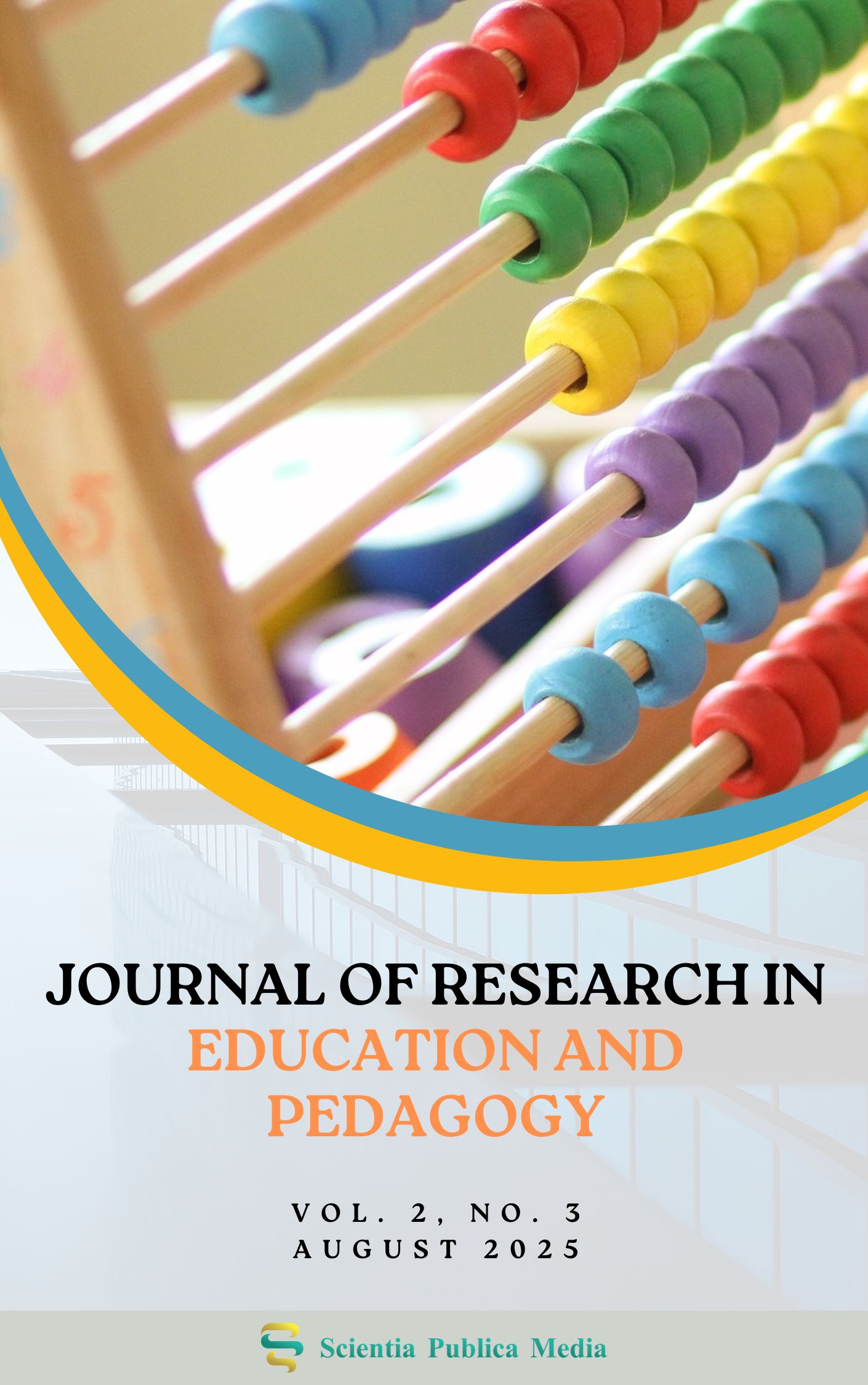Socio-Demographic Patterns on Child Abuse among Secondary School Students in Uganda
DOI:
https://doi.org/10.70232/jrep.v2i3.79Keywords:
Socio-Demographic, Child Abuse, Interventions, Secondary School, StudentAbstract
Child abuse remains a critical global concern with millions of children experiencing physical abuse at home with most of them living with mothers who suffer emotional abuse, hence becoming a serious problem. This study sought to examine the socio-demographic patterns of child abuse among secondary school students in Uganda. The study underscored the relationship between socio-demographic characteristics and levels of abuse experienced. Using a convergent parallel research design that combined both quantitative and qualitative methods. Data were collected from 239 students and 11 school administrators through questionnaires and in-depth interviews. Quantitative data were analyzed using Adjusted Odds Ratios (AOR), Confidence Intervals (CI), and p-values, while qualitative data were analyzed thematically. The findings revealed significant socio-demographic disparities in abuse experiences and reporting patterns. Female students were more likely to report abuse (AOR = 1.4, CI: 1.0–2.1, p < 0.022), indicating gender-specific vulnerabilities, while male students tended to underreport incidents due to stigma and societal expectations. Additionally, students from certain schools reported higher rates of physical and sexual abuse (AOR = 2.1, CI: 1.2–3.8, p < 0.022), highlighting the influence of institutional factors and the urgent need for improved oversight and accountability. Qualitative findings confirmed that physical harm, sexual harassment, and emotional abuse were the most common forms of abuse. Based on these findings, the study recommends strengthening gender-sensitive interventions, auditing and reforming school policies, tailoring child protection strategies to different socio-demographic groups, simplifying reporting mechanisms to be more child-friendly, and implementing comprehensive awareness campaigns. Therefore, there should be stronger national child protection policies within the education sector are crucial for ensuring the safety and well-being of children in Uganda.
Metrics
References
Akello, G., Reis, R., & Richters, A. (2010). Silencing distressed children in the context of war in northern Uganda: An analysis of its dynamics and its health consequences. Social Science & Medicine, 71(2), 213–220. https://doi.org/10.1016/j.socscimed.2010.03.030
Anwar, Y., Sall, M., Cislaghi, B., Miramonti, A., Clark, C., Faye, M. B., & Canavera, M. (2020). Assessing gender differences in emotional, physical, and sexual violence against adolescents living in the districts of Pikine and Kolda, Senegal. Child Abuse & Neglect, 102, 104387.
Bailey, A. (2024). Empowering Faith-Based Support: Resource Development for Domestic Violence Survivors in Church Organizations (Doctoral dissertation, Regent University).
Bukhari, S. A. R. (2021). Sample size determination using Krejcie and Morgan table. https://doi.org/10.13140/RG.2.2.11445.19687
Currie, D. W., Apondi, R., West, C. A., Biraro, S., Wasula, L. N., Patel, P., ... & Massetti, G. M. (2021). A comparison of two population-based household surveys in Uganda for assessment of violence against youth. PLoS one, 16(12), e0260986.
Dickson, K. S., Ameyaw, E. K., Adde, K. S., Paintsil, J. A., & Yaya, S. (2024). Social determinants of child abuse: Evidence from seven countries in sub-Saharan Africa. PLoS one, 19(7), e0305778.
González-Rodríguez, D., Vieira, M.-J., & Vidal, J. (2019). Factors that influence early school leaving: A comprehensive model. Educational Research, 61(2), 214–230. https://doi.org/10.1080/00131881.2019.1596034
Gewirtz-Meydan, A. & Finkelhor, D. (2020). Sexual abuse and assault in a large national sample of children and adolescents. Child maltreatment, 25(2), 203-214.
Kim, H., & Drake, B. (2023). Has the relationship between community poverty and child maltreatment report rates become stronger or weaker over time? Child Abuse & Neglect, 143, 106333. https://doi.org/10.1016/j.chiabu.2023.106333
Logie, C. H., Okumu, M., Mwima, S., Hakiza, R., Irungi, K. P., Kyambadde, P., ... & Narasimhan, M. (2019). Social ecological factors associated with experiencing violence among urban refugee and displaced adolescent girls and young women in informal settlements in Kampala, Uganda: a cross-sectional study. Conflict and health, 13, 1-15.
Maier, A., Daniel, J., Oakes, J., & Lam, L. (2017). Community Schools as an Effective School Improvement Strategy: A Review of the Evidence. Learning Policy Institute.
Morris, M. C., Marco, M., Maguire-Jack, K., Kouros, C. D., Bailey, B., Ruiz, E., & Im, W. (2018). Connecting Child Maltreatment Risk with Crime and Neighborhood Disadvantage Across Time and Place: A Bayesian Spatiotemporal Analysis. Child Maltreatment, 24(2), 181–192. https://doi.org/10.1177/1077559518814364
Nabunya, P., Curley, J., & Ssewamala, F. M. (2021). Gender norms, beliefs and academic achievement of orphaned adolescent boys and girls in Uganda. The Journal of genetic psychology, 182(2), 89-101.
Nakabazzi, B., Wachira, L. J. M., Oyeyemi, A. L., Ssenyonga, R., & Onywera, V. O. (2020). Prevalence and socio-demographic correlates of accelerometer measured physical activity levels of school-going children in Kampala city, Uganda. PloS one, 15(7), e0235211.
Nanfuka, S. (2023). Cultural norms and sexual abuse in Uganda: A critical review. https://journals.eanso.org/index.php/eajtcr/article/download/1148/1628/
Nyangoma, A., Ebila, F., & Omona, J. (2019). Child Sexual Abuse and Situational Context: Children’s Experiences in Post-Conflict Northern Uganda. Journal of Child Sexual Abuse, 28(8), 907–926. https://doi.org/10.1080/10538712.2019.1660445
Ochoa, M. C., & Samie-Jacobs, N. (2024). Fast Facts: Violence against children widespread, affecting millions globally. New York: UNICEF.
Protective factors for adolescent sexual risk behaviours and experiences linked to HIV infection in South Africa: A three-wave longitudinal analysis of caregiving, education, food security, and social protection. BMC Public Health, 23(1), 1452. https://doi.org/10.1186/s12889-023-16373-5
Save the Children. (2022). Uganda child protection initiative. [focus on international peace support training centre (IPSTC). peace and security, 31.
Sekiwu, D. (2020). Vocalizing Qualitative Methodologies in Education Research. Postgraduate Research Engagement in Low Resource Settings, 58–83.
Sserwanja, Q., Kawuki, J., & Kim, J. H. (2020). Increased child abuse in Uganda amidst COVID‐19 pandemic. Journal of Paediatrics and Child Health, 57(2), 188–191. https://doi.org/10.1111/jpc.15289
UNICEF. (2020). Child protection and rights in Uganda. https://doi.org/10.1016/j.chiabu.2021.105134
Wan, M., Carlson, D. S., Quade, M. J., & Kacmar, K. M. (2022). Does work passion influence prosocial behaviors at work and home? Examining the underlying work–family mechanisms. Journal of Organizational Behavior, 43(9), 1516-1534.
Wandera, S. O., Clarke, K., Knight, L., Allen, E., Walakira, E., Namy, S., … & Devries, K. (2017). Violence against children perpetrated by peers: A cross-sectional school-based survey in Uganda. Child abuse & neglect, 68, 65-73.
Downloads
Published
Issue
Section
License
Copyright (c) 2025 Ninsiima Patience, Bashaija Athanansio, Justine Momanyi Omare

This work is licensed under a Creative Commons Attribution-NonCommercial 4.0 International License.


